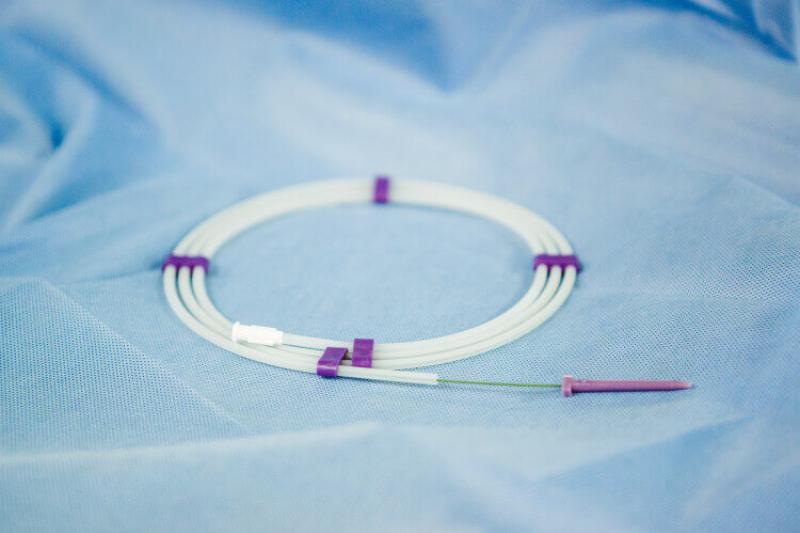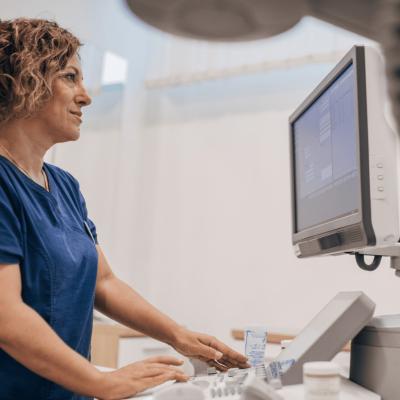- AdventHealth University

Technology has had a widespread positive impact on the medical field, making healthcare more efficient, saving money, and improving patient experiences and outcomes. Virtually every area of the industry has benefited from technology, including radiology and medical imaging. For example, vascular interventional radiology uses modern imaging equipment to perform minimally invasive vascular procedures. The application of these innovative techniques has expedited patient recovery and reduced the risks associated with procedures.
This subspecialty of radiology captures images of blood vessels, which physicians use to diagnose and treat patients. Becoming a vascular interventional technologist entails education, specific skills, an understanding of the field and equipment, and certification. Therefore, earning a bachelor’s in imaging sciences can be the first step toward becoming a vascular technologist.
Vascular Interventional Radiology: Definition and Equipment Used
Vascular interventional radiology is the use of imaging to guide minimally invasive vascular procedures, such as stenting or angioplasty. The goal of this specialty is to use the least invasive techniques and technology to diagnose and treat patients, according to Johns Hopkins. Doing so minimizes the risk of a procedure while reducing pain and recovery time. Vascular interventional radiology procedures often involve an interventional radiologist passing a needle through a small incision or inserting small probes or catheter tubes to reach the diagnosis or treatment location. Treatments for conditions in the following areas use vascular interventional radiology:
- Narrowed or blocked bile ducts
- Cancer
- Infertility
- Pain
- Peripheral arterial diseases
- Trauma and bleeding
- Stroke
As illustrated below, professionals in this field use various technologies and imaging techniques to inform diagnoses and also assist physicians in viewing, navigating, and placing catheters in veins.
Fluoroscopy
Fluoroscopy is an imaging technology that produces a continuous X-ray beam to produce images of blood vessels. A monitor displays the image, which tracks the movement of body parts or an instrument through the body. The placement of a vascular catheter is an example of a procedure that entails fluoroscopy.
Digital Radiography
Digital radiography is a type of technology that directly converts X-rays into a digital image. This process is instantaneous and is considered an advanced form of X-ray. This technology offers shorter radiation exposure times for patients and enhanced image quality.
Computed Tomography
Computed tomography, also known as CT, is a digital imaging modality that can produce cross-sectional and three-dimensional images of the body. The images are much more detailed than typical X-ray images, showing soft tissues, blood vessels, and bones. Physicians use them to diagnose diseases.
Sonography
Sonography, also known as ultrasound, uses high-frequency sound waves to produce images of structures within the body. The technology is most known for viewing the uterus during pregnancy, but in cardiovascular radiology, physicians use it to evaluate blood flow and function.
Magnetic Resonance Imaging
Magnetic resonance imaging, also known as MRI, captures detailed images of organs and tissues without the use of radiation. Physicians can use this technology to diagnose various diseases, including those in the brain such as aneurysm and stroke.
Vascular Technologist Overview
Those working in vascular interventional radiology are known as vascular technologists. Their tasks include preparing patients for procedures, maintaining and operating diagnostic imaging equipment, reviewing images for abnormalities, and recording findings. They assist radiologists in minimally invasive procedures by utilizing imaging for guidance. For example, when a doctor is placing a catheter, the vascular technologist helps demonstrate the catheter location using a C-arm, which uses fluoroscopy to provide real-time imaging. A vascular technologist will explain procedures to the patient and analyze the results before summarizing them for a physician.
Skills
A successful vascular technologist maintains a specific skill set, including:
- Detail orientation. When working alongside a physician, vascular technologists must follow their exact instructions and be precise in everything they do.
- Interpersonal skills. Vascular technologists need to know how to interact with patients and establish relationships with them.
- Physical fitness. Since vascular technologists stand during long operations and perform tasks such as moving and lifting patients, fitness is an important part of the job.
Education
Given their integral role in minimally invasive vascular procedures, vascular technologists must have a strong education. This can include an associate or bachelor’s degree in a relevant field such as imaging sciences or radiography. Afterwards, they must complete primary certification in radiography through the American Registry of Radiologic Technologists (ARRT). The next step is to complete education for ARRT post-primary certification in vascular interventional radiography. Degree programs, such as the Bachelor of Science in Imaging Sciences at AdventHealth University Online, often include specialty tracks in vascular intervention.
Salary and Job Outlook
According to the U.S. Bureau of Labor Statistics (BLS), diagnostic medical sonographers and cardiovascular technologists and technicians, including vascular technologists, earned a median annual salary of $68,750 in 2019. Many factors influence salaries, including education, experience, and certifications. PayScale, for example, lists the median annual salary of ARRT-certified vascular technologists as about $73,700 as of March 2021.
The BLS projects employment in this field to grow 12% between 2019 and 2029, slightly faster than the average growth for all occupations (4%). The aging population and increased need for diagnosis of heart disease and other issues will drive the need for vascular technologists and other imaging professionals.
Pursue a Career in Vascular Interventional Radiology
Education is the first step toward a career in vascular interventional radiology. AdventHealth University Online’s Bachelor of Science in Imaging Sciences program provides radiologic technologists with skills and experience in management, new imaging technology, and organizational communication through courses such as Management Principles for Imaging Professionals and Issues and Trends in the Healthcare Arena. The program also offers six specialization tracks, including vascular interventional radiology.
Additionally, AdventHealth University Online’s Advanced Imaging Certificate in Vascular Interventional Radiography program prepares imaging technologists for the ARRT certification exam. Take the first step to become a vascular technologist today.
Recommended Readings
How to Become an MRI Technologist
How to Become a Radiology Director
Types of Medical Imaging: Technologies and Career Options
Sources:
American Registry of Radiologic Technologists, Vascular Interventional Radiography
Association of American Medical Colleges, Vascular and Interventional Radiology
The Balance Careers, “Cardiovascular Technologist”
Healthline, “CT (Computed Tomography) Scan”
Johns Hopkins Medicine, Vascular and Interventional Radiology Conditions and Treatments
Johns Hopkins Medicine, “What Is Vascular and Interventional Radiology”


